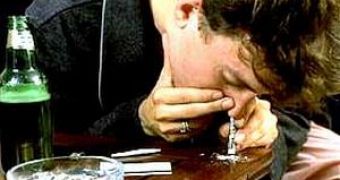Snorting cocaine through a rolled-up banknote lets an indelible "fingerprint" of the drug on the note.
But the banknotes can get trace of the drugs also through transferring the drug, dealing it or the cross-contamination of notes during the counting process in financial institutions.
A research made by PhD student, Jonathan Bones - working under the supervision of Professor Brett Paull at DCU's National Centre for Sensor Research (NCSR) which specializes in sensor technology used in medical diagnostics, environmental monitoring and other industrial applications - has found that in a sample of 45 banknotes in the greater Dublin area, all the notes were contaminated with cocaine.
The researchers employed a technique based on chromatography/mass spectrometry. As Euro banknotes have a cotton structure, they easily absorb chemical residues, than can be analyzed. Besides cocaine contamination, three notes contained heroin.
62% of the banknotes presented cocaine levels greater than 2 nanogrames/note, but 5% of the them pointed greater than 100 times higher levels, thus direct use of the note, for dealing or inhalation. The ones in the second category were mostly ?20 and ?50 banknotes, while ?5 and ?10 banknotes revealed the lowest level of cocaine.
The other notes, presenting only ultra-trace cocaine amounts, were most likely contaminated by the contact with other contaminated notes, within bank counting machines or human handling. "This is the largest sample of notes ever used in an experiment of this kind in Ireland", said Bones.
"A larger number of notes would give a more representative view of cocaine use in our society, but the number used is sufficient from which to draw conclusions. The most recent survey carried out in the US showed 65% of dollar notes were contaminated with cocaine. However, the 100% rate uncovered in this project was surprising. Although not a quantitative measure, the presence of illicit substances on banknotes in general circulation provides an indication of the degree to which substances are being used by the community".
"The greatest advantage to using money as the test matrix is that it is readily available, non-invasive, anonymous and relatively safe to work with. Further research would need to be carried out to provide a more accurate picture of the scope of cocaine and heroin use in Ireland today", said Paull.

 14 DAY TRIAL //
14 DAY TRIAL //